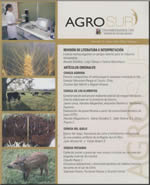PRELIMINARY STUDY ON ANTIMICROBIAL EFFECTS “IN VITRO” OF Sphagnum magellanicum BRID
Main Article Content
Abstract
Among the current tendencies in the study and use of medicinal plants, efforts are concentrated on the search for complexes that provide new active substances with antimicrobial activity. In the present study evaluations of the antimicrobial activity of Sphagnum magellanicum moss were carried out in 4 states: fresh, dried, sterilized and non-sterilized. In order to isolate the active components from the moss, different extractions were prepared using water, ethyl alcohol at 96%, acetone and hexane, and a process of rehydration, in the case of dried moss. The following bacteria and fungi were used as test microorganisms: Staphylococcus aureus, Streptococcus agalactiae, Bacillus cereus, Escherichia coli, Salmonella enteritidis, Pseudomona aeruginosa, Malassezia pachydermatis and Candida albicans. The selection of these microoganisms, was made so that Gram-positive bacteria, Gram- negative bacteria and yeast-like fungi groups would be included. The technique of Kirby-Bauer was used, a standard to measure sensitivity by diffusion in agar. The results showed antimicrobial activity only by Sphagnum moss in the fresh state and without being sterilized, extracted with acetone and hexane. The most sensitive microorganisms to the moss extract were the yeast-like fungi (which presented a greater diameter halo of inhibition), followed by Gram-positive bacteria and fnally the Gram-negative bacteria. No effect was observed on P. aeruginosa.

